The Wall That Saved a Village: The Legacy of Kotaku Wamura
A visionary mayor’s unwavering resolve to build a towering seawall saved Fudai, Japan, from the deadly 2011 tsunami, proving the life‑saving power of foresight against all odds.
If you have similar stories to share, please click here to contribute.
Do you want to receive similar stories in your mailbox even after the initial fortnight? Then, Become a Paid Member of HydroGeek.Click here to Upgrade. Do you want to pay in USD? Click here.
We have a Podcast also. Click here to subscribe.
Do you want to sponsor this newsletter? Then email to editor.at.baipatra.ws with your proposal. Your message can reach more than 1000 active subscribers.
In the quiet fishing village of Fudai, nestled along Japan’s northeastern coast, one man’s stubborn vision stood tall—literally and metaphorically—against the tide of skepticism. Kotaku Wamura, mayor of Fudai in the 1960s, was ridiculed for what many considered a reckless and unnecessary endeavor: the construction of a 51-foot-high seawall and floodgate. Critics scoffed at the multimillion-dollar project, calling it a financial blunder that drained village resources for a threat that might never materialize.
But Wamura’s conviction was rooted in history. He had grown up hearing harrowing accounts of the 1896 Meiji–Sanriku tsunami, whose towering 15-meter waves had obliterated coastal communities. That memory haunted him, and when it came time to protect his village, he refused to compromise. Even when his own council opposed him, even when the cost ballooned to what would be $30 million today, Wamura stood firm. He demanded the wall be built to withstand the worst-case scenario—not the most convenient one.
The wall was completed, but the price Wamura paid was steep. His reputation suffered, and he retired under a cloud of criticism. In 1997, he passed away, never knowing whether his controversial decision would ever be vindicated.
Then came March 11, 2011.


